Bistek tagalog, a classic Filipino dish, is a delightful beef steak marinated in a tangy blend of soy sauce, calamansi juice, and aromatic spices. This delectable dish is easy to prepare and requires minimal ingredients, making it a popular choice for both weeknight dinners and special occasions. In this recipe post, we will guide you through the steps to create a mouthwatering bistek while sharing some valuable tips along the way. So, let’s dive into the flavorsome world of this Filipino beef steak! Not eating beef? you can try the chicken bistek version or pork bistek version.
Bistek Tagalog: A Family Favorite That Brings Back Memories
Growing up in Cavite, bistek tagalog was one of those dishes that seemed to show up at every family gathering. Whether it was a casual Sunday lunch or a more festive occasion, this tangy and savory Filipino beef steak always found its way onto the table. My mom, Nanay Lina, would tell us how she learned the recipe from my Lolo Pedro, who loved the simplicity of its ingredients but insisted on precise preparation. “It’s the marination,” he would say with a serious nod, “that makes or breaks it.”
Today, I’m excited to share not just the recipe but also some tips and stories behind this beloved dish. If you’re new to cooking bistek, don’t worry! It’s simple enough for beginners yet satisfying enough to impress anyone at the table.
The Secret Behind a Flavorful Bistek Tagalog
At its heart, bistek tagalog is all about balance—savory, tangy, and just the right hint of sweetness. The marinade is where the magic happens. A mix of soy sauce and calamansi juice does the heavy lifting here, infusing the meat with a vibrant flavor that’s both comforting and exciting. My cousin Marites once tried to substitute calamansi with lemon when she moved abroad, but she always said it didn’t taste quite the same. “It’s the calamansi that gives it that Pinoy authenticity,” she said.
Letting the beef sit in this marinade for at least an hour (though overnight is even better) allows the flavors to seep deep into the meat, ensuring every bite is bursting with goodness. The addition of Knorr liquid seasoning and a sprinkle of MSG (or vetsin, as my Tita Baby calls it) brings a layer of umami that makes the dish irresistible.
The Role of Broth: A Pro Tip from Lolo
One thing that sets our family’s bistek apart is the use of homemade soup stock. Lolo Pedro always believed that boiling beef or pork bones with onion and garlic created a rich, aromatic base that elevated the dish. While it takes a bit of time to make, the depth of flavor it adds is undeniable.
If you’re short on time, dissolving a beef cube in hot water is a quick and effective alternative. It’s what I used during my college days when I craved home-cooked meals but was too busy studying. Either way, the broth helps tenderize the beef while creating a savory sauce that coats the dish beautifully.
Cooking Techniques That Make a Difference
When it’s time to cook the beef, frying it until browned is essential. This step not only locks in the juices but also creates a slightly crispy texture that contrasts nicely with the tender meat. I remember my brother Junjun jokingly calling this the “magic crust” because of how it enhanced the overall taste.
After frying, the reserved marinade and soup stock are added to the pan and brought to a gentle boil. This slow simmering process is key—it allows the beef to become incredibly tender while blending the marinade and broth into a rich, silky sauce. Patience is your best friend here; don’t rush the cooking time.
Finally, sautéing the onions until they’re just slightly softened adds a touch of sweetness to balance the dish. My Ate Virgie always insisted on using white onions for their milder flavor, and she wasn’t wrong. These onion rings, when placed on top as a garnish, not only look beautiful but also provide a fresh, slightly crisp bite.
A Dish Rooted in Tradition
Bistek tagalog isn’t just a meal; it’s a reflection of Filipino ingenuity and resourcefulness. Originating from Spanish influence during colonial times, this dish was adapted using local ingredients like calamansi to suit the Filipino palate. Over generations, it has evolved into a staple in many households, each family adding their own twist to make it uniquely theirs.
Even now, whenever I make bistek tagalog, I’m reminded of my family’s kitchen—of Lolo’s stories, Nanay’s meticulous instructions, and the laughter that always filled the air. It’s amazing how a simple dish can hold so much history and love.
Variations to Explore
If beef isn’t your thing, don’t worry! Chicken or pork bistek are excellent alternatives. In fact, my best friend Minda swears by her pork bistek version, which she says has a slightly richer flavor. The key is to follow the same marination and cooking techniques to achieve that signature bistek taste.
For those living abroad and struggling to find calamansi, bottled calamansi juice is a great substitute. While fresh is always best, this little hack ensures you can enjoy authentic flavors no matter where you are.
Why You Should Try Bistek Tagalog
Bistek tagalog is more than just food; it’s a gateway to Filipino culture and a reminder of home. It’s a dish that brings people together, whether you’re cooking for your family or sharing it with friends. The combination of tender beef, savory sauce, and sweet onions is pure comfort on a plate.
So, what are you waiting for? Grab your ingredients and give this bistek recipe a try. As Lolo Pedro used to say, “The best bistek isn’t just cooked with your hands—it’s made with your heart.”
How to Cook Bistek Recipe (Filipino Beef Steak)
Equipment
- frying pan
Ingredients
- 500 grams beef sliced thinly
- 4 Tbsp. soy sauce
- 8 pieces calamansi (extract juice)
- 2 Tbsp. Knorr liquid seasoning
- 1 cup soup stock (or beef cube + 1 cup water)
- 4 Tbsp. cooking oil
- 2 pcs big onion sliced into rings
- ground pepper
- MSG to taste optional
Instructions
How to cook bistek:
- Marinate beef in calamansi juice, soy sauce, Knorr liquid seasoning, pepper, and MSG for at least an hour.
- To make soup stock, boil beef or pork bones and add onion and garlic. Simmer for 2 to 3 hours then use the broth as soup stock.
- You can also use beef cube + 1 cup hot water to dissolve the beef cube instead of making the soup stock.
- In a pan, heat some oil and stir fry onions until half cooked. Set aside.
- Fry beef in oil until brown. Add soup stock and marinade then boil until meat becomes tender.
- Add more water if necessary until the beef is tender and there is some liquid left.
- Season to taste. Garnish with onion rings. Serve hot.
Video
Notes
Cooking Tips for Perfect Bistek
Marinate the Beef for Maximum Flavor
Marinating the beef is essential to achieve the rich, tangy taste that makes bistek unique. Let the beef soak in the marinade for at least an hour, or even overnight, to allow the soy sauce and calamansi to penetrate deeply into the meat. This step not only enhances the flavor but also helps tenderize the beef, making each bite more enjoyable.Use Fresh Calamansi for Authentic Taste
Fresh calamansi juice gives bistek its signature bright and tangy flavor. While lemons or limes can work in a pinch, they lack the distinct citrusy aroma that calamansi provides. If you can’t find fresh calamansi, bottled calamansi juice is a good alternative, but always opt for fresh when possible for the best results.Simmer Low and Slow for Tender Beef
Cooking the beef gently over low heat ensures that it becomes melt-in-your-mouth tender. Rushing this process or using high heat can make the meat tough and chewy, so patience is key. Allow the marinade and soup stock to reduce gradually, creating a luscious sauce that clings perfectly to the beef.Nutrition Notes:
Calorie and other nutrition information is derived from HappyFolks.Com recipe nutrition calculator. The percent daily value (%DV) is based on a daily 2,000 calorie diet.Nutrition Information:
Amount per Serving:468g, Calories:1161kcal, From fat:908, Total fat:101.4g, Saturated Fat:34.4g, Trans Fat:0.2g, Cholesterol: 178mg, Sodium: 1148g, Total Carbohydrate: 16g, Dietary Fiber: 2g, Sugars: 8g, Protein: 47g, Vitamin C: 16%, Vitamin A: 7%, Calcium: 5%, Iron: 32%
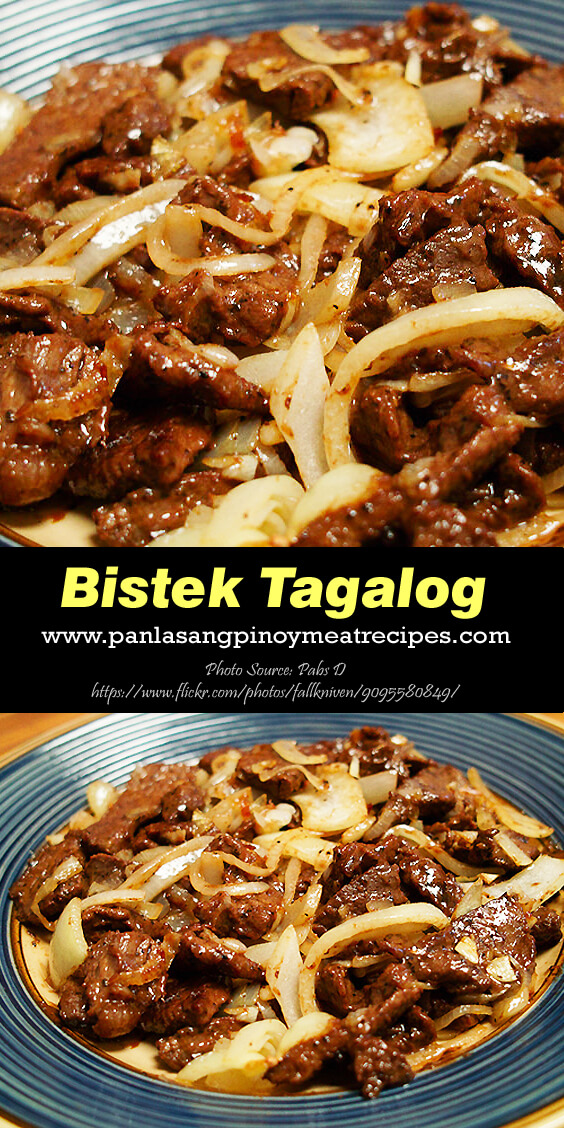

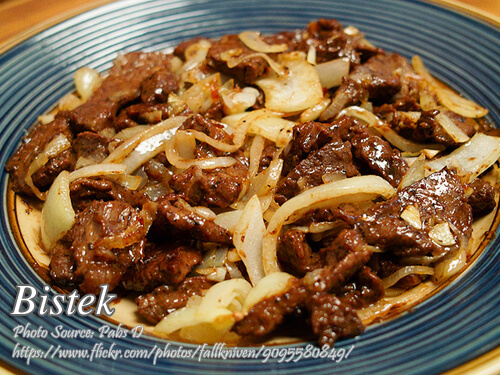
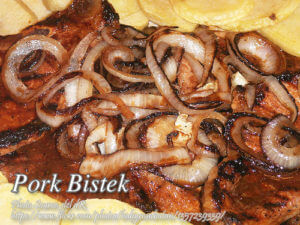
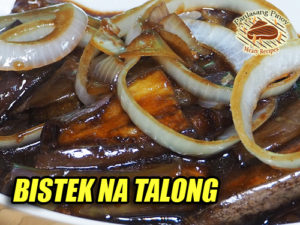
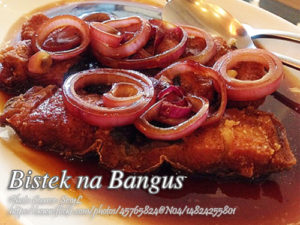

Hi Devin, its more practical to measure the calamansi by piece. What I’ve written in the ingredients is 8 pcs calamansi, then extract the juice. Its like a piece of lemon, then extract the juice from the lemon.
You mention 4-8 Pcs of Calamansi juice. What does that translate into oz or any other kind of measurement?
Hi Kuya Manny, what is the best type or brand of soy sauce for bistek? Salamat po!
Hi Armids, if you can find Maggi Soy, I think it will taste great.
Hi Joshua, thanks for your comment. I’m sure you can cook this with ease.
Wow yummy! I want to try cooking this bistek recipe!